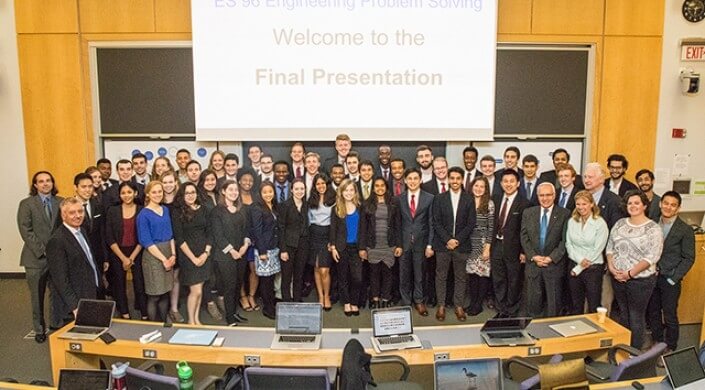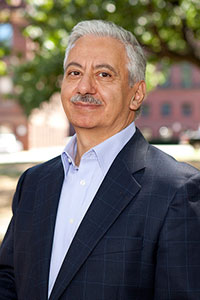News
Students in Engineering Problem Solving and Design Project (ES 96) explored the problems around transportation connectivity, and develop solutions aimed at easing the burden on residents and travelers. (Photo by Eliza Grinnell/SEAS Communications)
Rail travelers passing through Boston on the busy northeast corridor are met with a one-mile gap between the city’s North and South stations that requires them to use an alternative mode of transportation—subway, bus, Uber, or their own two feet—to continue their journeys.
For nearly a century, local, state, and national officials have discussed the idea of boring an underground tunnel linking the two stations, in an effort to increase rider capacity and decrease congestion. Now, a team of Harvard John A. Paulson School of Engineering and Applied Sciences (SEAS) students have added their voices to the debate.
Students in Engineering Problem Solving and Design Project (ES 96) worked with seven different client organizations, including the Massachusetts Department of Transportation, the Massachusetts Bay Transportation Authority, and Arup, an engineering consulting firm in Boston, to study the problems around transportation connectivity, and develop solutions aimed at easing the burden on residents and travelers.
Forty-five engineering students, divided into three semi-independent teams, all came to the same conclusion—the North South Rail Link (NSRL) is not the ideal solution to the problems they explored. Instead, they proposed six different solutions designed to meet the same objectives of the NSRL—ridership growth, increased system capacity, operational efficiencies, air quality improvements, and redevelopment opportunities.
One solution calls for a dedicated lane for rapid transit buses that forms a ring around the city. The Urban Ring would link North and South stations while also allowing commuters to travel circumferentially around the city, alleviating some of the downtown congestion that results from the city’s radial transportation structure.
This subgroup, led by Matthew Li, S.B. ’19, an electrical engineering concentrator, also proposed adding additional bike lanes to relieve congestion and launching a network of large capacity, low-clearance ferries that could shuttle travelers between North and South stations without clogging city streets or overcrowded subway cars.
Visitors to Amsterdam can travel along the city's many canals aboard low-clearance ferries like this one.
“I think that these ideas have potential to really benefit people in Boston. We think that we can revitalize the system with new features that will improve people’s daily commute experiences and also help make Boston a hub of innovation by enabling transportation connectivity,” Li said. “A big bottleneck for the growth of a city is transportation. With better connectivity, we can create so much more economic potential for the city of Boston.”
Also studying the idea of circumferential transportation, a second sub group, led by Cat O’Donnell, S.B. ’19, an electrical engineering concentrator, explored the implementation of a monorail system that could connect North and South stations, as well as some of the city’s existing subway and commuter rail stations.
Not only would their proposed monorail system shuttle travelers between North and South station in 10 minutes, faster than the subway or above-ground routes, it would also alleviate congestion since commuters could use it to connect between stations and avoid overcrowded transfers. And with an estimated price tag of $2 billion, less than one third the cost of the proposed NSRL, the five-mile monorail could meet the same objectives while being less of a drain on state coffers, she said.
However, challenges arising from building in Boston’s crowded—and expensive—urban core, as well as the impact of weather on the tracks, would require careful consideration if this solution were to move forward, O’Donnell said.
The Vancouver SkyTrain monorail (pictured above) has an average daily ridership of nearly 490,000 passengers.
“Like any transport system, this monorail would need to be able to integrate really well into the existing infrastructure and meet the needs that are there. You can’t just build a transport system that fixes a problem that maybe isn’t one of the main issues,” she said. “When looking to build any transport system, you have to think about what the problems really are and how this solution would help.”
Rather than building something new, the third sub-team studied the benefits of improving the infrastructure that already exists. To increase ridership and reliability, the team, led by Sam Meijer, S.B. ’19, a mechanical engineering concentrator, explored the creation of a better bus tracking system that uses real-time data to generate arrival time predictions. Better information about delays will help riders make decisions further in advance about taking alternate routes or an earlier bus, improving the rider experience, said Renee Friedman, S.B. ’19, a bioengineering concentrator.
The team also studied delays and found that a large proportion are caused by rail failure. They designed a sensor array that could be fitted to the underside of trains, using accelerometer and vibration data to identify rail failures without the need to have crews walking the rails each night. The system could also be used to proactively identify areas of track that may be susceptible to failure in the near future.
Sam Meijer, S.B. ’19, a mechanical engineering concentrator, works on his team's prototype in the Active Learning Labs. (Photo by Adam Zewe/SEAS Communications)
“It has much wider implications outside of just Boston itself. You could imagine this running on rail networks anywhere and flagging delays,” Meijer said. “The idea is pretty powerful that you could run this on normal trains going over the rails and reduce delays caused by breakages, improve rider comfort by identifying areas of bumpiness, and reduce the expenditure of train operating companies.”
While the students conducted detailed analyses of each proposed solution, including such factors as cost, time to implement, impact on the environment, and potential to reduce commute times and alleviate congestion, they recognized that none of their proposals was a silver bullet.
“A big challenge we would face is convincing politicians and policymakers of these solutions,” Li said. “The city has already invested millions of dollars into studies of whether the NRSL should be done or not. We are demonstrating how our solutions would be cheaper and better for the environment, but we’d still face an uphill battle to generate that buy-in.”
While former Massachusetts Gov. Michael Dukakis, a long-time proponent of the NSRL, lauded the students for their efforts and emphasized the well-thought-out solutions they proposed, he stressed that the NSRL should still be a priority for lawmakers. The connector continues to serve as an essential part of the equation, Dukakis said, since it addresses the issue of building a robust Northeast Corridor transportation network.
Instructor Fawwaz Habbal, Executive Dean for Education and Research, was impressed by the students’ problem solving ability and their focus on systems level thinking. Even though they were divided into three teams, they collaborated closely throughout the semester, and that teamwork helped them carefully study and prepare each solution, he said.
“They didn’t take the answer for granted. The students truly investigated everything. They tried to find the root causes rather than just trying to fix each problem quickly,” he said. “My hope is that they learn that engineering is much broader than technical solutions.”
The course was co-taught by Kelly Miller, Senior Preceptor in Applied Physics, Christopher Lombardo, Associate Director for Undergraduate Studies in Engineering Sciences, and Nabil Harfoush, Visiting Associate Professor in Engineering Sciences.
Topics: Academics
Cutting-edge science delivered direct to your inbox.
Join the Harvard SEAS mailing list.
Scientist Profiles
Fawwaz Habbal
Senior Lecturer on Applied Physics
Press Contact
Adam Zewe | 617-496-5878 | azewe@seas.harvard.edu




